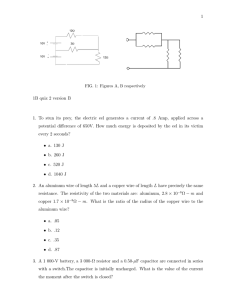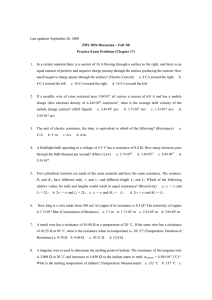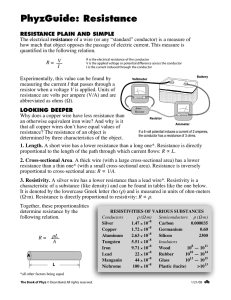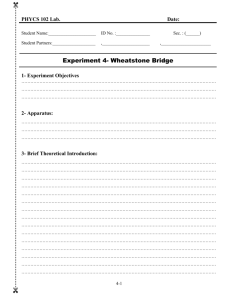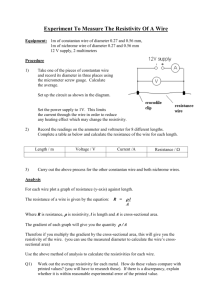Electric Current - Camden Central School
advertisement
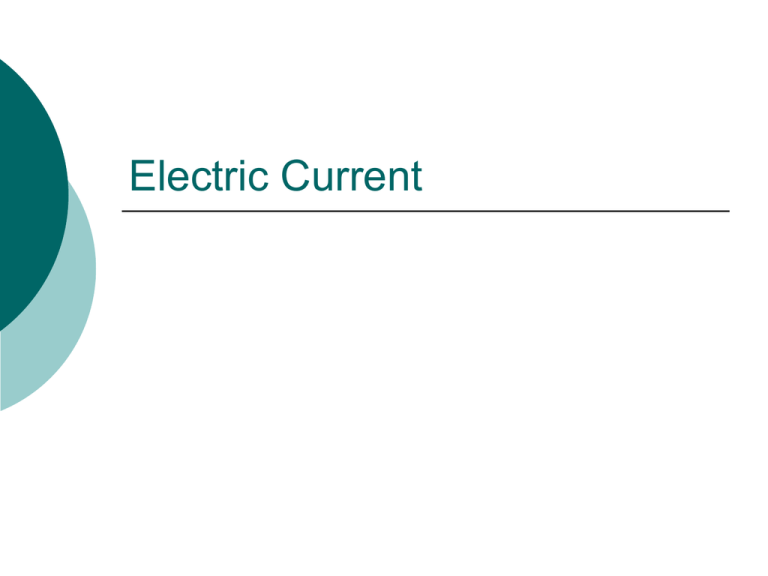
Electric Current Answer Me!!! Why are electric wires made from metal? Conductivity Metals are good conductors of electricity. This is because metals have “free” electrons that can easily flow through a metal. Nonmetals are poor conductors of electricity, because electrons cannot move easily through them. Periodic Table of Elements Electric Current Electric Current is the number of charges that pass through a point in one second. Current is determined by the following equation: q I t I = current q = number of charge t = time If 1 Coulomb of charge passes through a point in 1 second, a current of 1 Ampere (A) is said to exist. Practice Problem 1 Two coulombs of charge pass a point in four seconds. How much current (I) flows through the conductor? Practice Problem 2 If 10 C of charge are transferred through an electric circuit in 5.0 seconds, what is the current in the circuit? Practice Problem 3 An operating lamp draws a current of 0.50 A. What is the amount of charge passing through the lamp in 10 seconds? Practice Problem 4 In a lightning flash, a charge of 10 C was transferred from the base of a cloud to the ground. The current was 1.0 x 104 A. Find the amount of time it took for the flash to travel. Final Thought… The current traveling from the cathode to the screen in a television picture tube is 5.0 x 10-5 A. How many electrons strike the screen in 5 seconds? Answer Me!!! What are 3 examples of good conductors of electricity? Potential Difference Potential difference pushes charges and causes them to flow. A battery can be used to create a potential difference. Potential difference is measured in volts (V) by a voltmeter. Current Flow There are two ways to describe current Conventional Current: Positive charge flows to negative. (Think electric field lines) Electron flow: Electrons flow from negative to positive. Resistance Resistance is the opposition to the flow of charges. The resistance of an object depends on characteristics of that object and the environment. Resistance is measured in Ohms (W) Ohm’s Law Although resistance is a property of the material current is passing through, potential difference and current are related to resistance by the following equation: V R I I = current measured in amperes R = resistance measured in ohms V = potential difference measured in volts Practice Problem 6 In a simple electric circuit, a 110 V electric heater draws 2.0 A of current. What is the resistance of the heater? Practice Problem 7 How much current flows through a 12W flashlight bulb running at 3 V? Practice Problem 8 What is the potential difference across a 2W resistor that draws 2 C of charge per second? Practice Problem 9 A metallic conductor obeys Ohm’s Law. Draw a graph that represents the relationship between potential difference (V) across the conductor and the resulting current (I) through the conductor. V I Answer Me!!! How could you change the resistance of a wire without changing the material it is made from? Resistivity Resistivity (r)is a measure of a material’s ability to resist the flow of electrical current. Resistivity is measured in Wm and common materials are found on your Reference Tables What determines resistance? Resistance (R) of a conductor is affected by its length (L), cross-sectional area (A), and resistivity (r) R rL A Temperature As the temperature of a material (most materials) is increased, the resistivity of that material will increase. Practice Problem 10 A copper wire is connected across a constant voltage source. The current flowing in the wire can be increased by increasing the wire’s Cross-sectional Area Length Resistance Temperature Practice Problem 11 The diagram below shows a circuit in which a copper wire connects points A and B. .A .B What can be done to decrease the electrical resistance between A and B? Practice Problem 12 A copper wire is part of a complete circuit through which current flows. Draw a graph that represents the relationship between the wire’s length and its resistance. Resistance Length Practice Problem 13 Several pieces of copper wire, all having the same length but different diameters, are kept at room temperature. Draw a graph that represents the relationship between resistance and cross-sectional area. Resistance Area Practice Problem 14 A 1.0 m length of nichrome wire with a cross-sectional area of 7.85 x 10-7 m2 is connected to a 1.5 V battery. Calculate the resistance of the wire.



